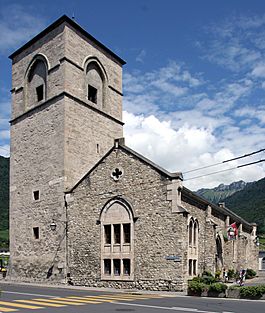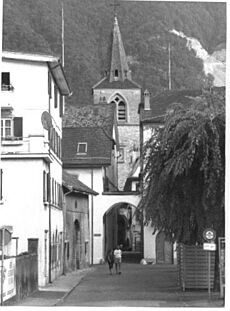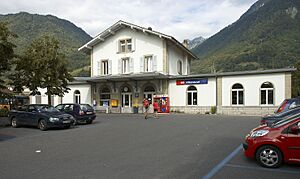Villeneuve, Vaud facts for kids
Quick facts for kids
Villeneuve
|
||
|---|---|---|

Villeneuve city hall
|
||
|
||
| Country | Switzerland | |
| Canton | Vaud | |
| District | Aigle | |
| Area | ||
| • Total | 31.98 km2 (12.35 sq mi) | |
| Elevation | 375 m (1,230 ft) | |
| Population
(Dec 2020 )
|
||
| • Total | 5,834 | |
| • Density | 182.43/km2 (472.48/sq mi) | |
| Demonym(s) | Les Villeneuvois | |
| Postal code |
1844
|
|
| Surrounded by | Montreux, Veytaux, Rossinière, Château-d'Œx, Corbeyrier, La Tour-de-Peilz, Noville, Ormont-Dessous, Rennaz, Roche | |
Villeneuve is a lovely town in Switzerland. It is part of the canton of Vaud and is located in the Aigle district. As of December 2018, about 5,771 people call Villeneuve home.
Contents
Exploring Villeneuve's Landscape
Villeneuve covers an area of about 32 square kilometers (12.4 square miles). A large part of this land, about 55%, is covered by forests. Another 27% is used for farming, growing crops or raising animals.
About 8% of the town's area has buildings and roads. A small part, 0.5%, is made up of rivers or lakes. The remaining 9.6% is land that cannot be used for farming or building, like rocky areas.
Villeneuve's Coat of Arms
The official symbol of Villeneuve is its coat of arms. It shows a golden shield with a blue eagle spreading its wings.
Who Lives in Villeneuve?
Villeneuve is a growing town. Between 1999 and 2009, its population grew by about 17.7%. Most of this growth was from people moving to Villeneuve.
Most people in Villeneuve speak French, about 79.4% of the population. German is the second most common language, spoken by 4.7% of residents. Italian is spoken by 4.1%.
Many people living in Villeneuve were born there or in the same canton (state). About 31% of the residents were born outside Switzerland.
The town has a good mix of ages. About 10.4% of the population are children aged 0-9, and 12.7% are teenagers aged 10-19. There are also many adults and older people, making it a diverse community.
Most homes in Villeneuve are private households, with an average of 2.3 people living in each. Many households (35.2%) have just one person.
The town has a mix of different types of buildings. About half of the inhabited buildings are single-family homes. Many buildings were built a long time ago, before 1919, but new ones are also being built.
The historical population of Villeneuve has changed over time, as shown in the chart below:

Important Sights in Villeneuve
The entire small town of Villeneuve is recognized as an important heritage site in Switzerland. This means it has special historical and cultural value.
Villeneuve's Economy
In 2010, Villeneuve had an unemployment rate of 7.6%. Many people in Villeneuve work in different areas.
- Primary Sector: A small number of people work in farming and forestry.
- Secondary Sector: Many people work in manufacturing (making things) and construction (building things).
- Tertiary Sector: The largest number of jobs are in this sector. This includes jobs in sales, transportation, hotels, restaurants, education, and healthcare.
Villeneuve is a place where more people come to work than leave for work. This means it's a busy center for jobs. Many people use public transportation or their cars to get to work.
Religion in Villeneuve
According to a 2000 census, about 40.3% of the people in Villeneuve were Roman Catholic. Another 32.7% belonged to the Swiss Reformed Church. There are also smaller groups of people who follow other Christian churches, Islam, Buddhism, and Hinduism. Some people do not belong to any church.
Learning and Education
Villeneuve has a good education system. Many adults (32.3%) have completed high school, and some (9.1%) have gone on to higher education at a university or college.
In the 2009/2010 school year, there were 615 students in Villeneuve's schools. The canton (state) provides two years of optional pre-school. After that, students attend primary school for four years, followed by six years of lower secondary school.
Some students from Villeneuve go to schools outside the town, and students from other towns also come to Villeneuve for school.
Getting Around: Transportation
Villeneuve has its own railway station, called Villeneuve VD. It is on the Simplon line, which connects to other towns like Grandson, Lausanne, and Aigle. This makes it easy for people to travel to and from Villeneuve.
Famous People from Villeneuve
Villeneuve has been home to some notable people:
- Romain Rolland (1866–1944): A French writer who won the Nobel Prize for Literature in 1915. He lived in Villeneuve between the World Wars and even met Mahatma Gandhi here.
- Oskar Kokoschka (1886–1980): An Austrian artist known for his powerful paintings. He settled in Switzerland after World War II.
- Henry James: A famous American writer who visited Villeneuve in 1872 with his sister and aunt. They stayed at the Hotel Byron, enjoying the Swiss peace, though their visit was cut short by hot weather.
Images for kids
See also
 In Spanish: Villeneuve (Vaud) para niños
In Spanish: Villeneuve (Vaud) para niños













